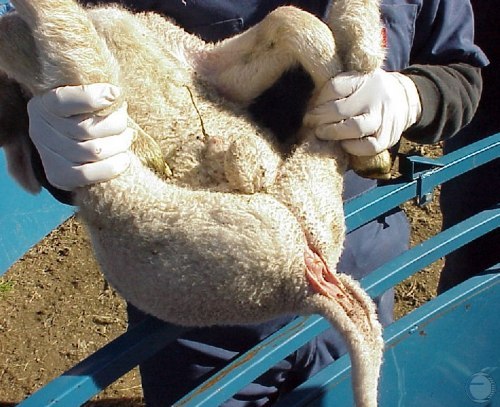

The need for castration is varies and is based on the management needs of the farm and preference of the market place. Ram lambs grow faster and have better body composition than wether lambs, and when ram lambs are marketed at a young age (less than 6 months), commercial lamb buyers usually do not discriminate in price. Ethnic lamb buyers often prefer intact (or entire) males and usually pay a premium for them.
It is usually not necessary to castrate ram lambs for the freezer (or locker) trade or when selling lamb directly to consumers, as there is no siginificant difference in the taste or tenderness of the meat from a young ram lamb versus a wether or ewe lamb. Older rams may have a slight taste difference and may not be as desirable for direct marketing. On the other hand, some consumers may prefer the taste of a male.
During harvest, it can be more difficult to remove the pelt (skin) from a ram lamb, especially one that has started to develop secondary sex characteristics. Ram lambs are typically dirtier at the time of slaughter. It may be advisable to castrate ram lambs that cannot be marketed by the time they are six months old.
Most importantly, wether lambs are easier to manage and eliminate the possibilities of early and/or unwanted pregnancies. When ram lambs are kept intact, it is necessary to wean and separate them from their dams and female pen (or pasture) mates by the time they are 4 months of age (later for later maturing breeds). If this cannot be done, ram lambs should be castrated. There are not many farmers have not had ewes bred “accidently” by ram lambs. Male lambs sold for grazing should be castrated as they will be easier to manage.
There are many techniques that can be used to castrate ram lambs. The easiest and most common method of castration is the rubber ring or band. Using an elastrator tool (or ring extender), the band is placed above the testicles, around the neck of the lamb’s scrotum. Care should be taken not to place the band over the lamb’s rudimentary teats. Banding will cause the testicles and scrotum to shrivel up and fall off in a few weeks. As with docking, the shriveled scrotum may be removed before it falls off. Both testicles must be below the placement of the band. If one testicle is missed, it will be retained in the belly cavity, resulting in a “bucky” lamb that will have male characteristics.
Castration by banding causes some pain to the lamb, but the pain is generally short-lived. Lambs should be castrated at a young age, preferably between 1 and 7 days of age. Castration in the first 24 hours may interfere with bonding and colostrum intake and is not recommended. As with tail docking, pain can be reduced if a clamp (using Burdizzo) is applied immediately before or after application of the ring.
Some veterinarians advocate the use of lidocaine to reduce the pain felt by the lamb; however, lidocaine is not available for purchase over-the-counter. As with banding tails, lambs should be protected against tetanus via passive immunity or use of the tetanus anti-toxin at the time of castration.
 Contact Jaguza Support
Contact Jaguza Support